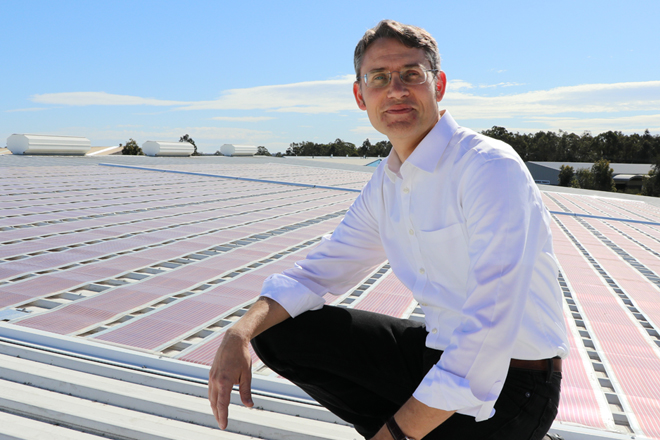Printing-press makeover for solar panels
What’s thin yet flexible, quick to make and install, and can turn the sun’s rays into energy?

What’s thin yet flexible, quick to make and install, and can turn the sun’s rays into energy?
It’s printed solar and it looks set to revolutionise our rooftops. An Australian research group has pledged to begin printing solar panels for this use commercially by 2023, although the tech could one day be used on a range of surfaces to generate clean, low cost, renewable energy.
The research team from the University of Newcastle’s Centre for Organic Electronics say their facility will soon be ready to roll out hundreds of metres of panels per day at a production cost of less than $10 per metre using a traditional printer.
“We are developing the first factory for printed solar in Newcastle and expect that this will be producing commercial product in 18 to 24 months’ time,” research team leader, Professor Paul Dastoor, told Cool Green Tech.
Moreover, the printed solar cells are very easy to install, he says. “They simply roll out, but large rooftop installations will require trained installers.”
"We are developing the first factory for printed solar in Newcastle and expect that this will be producing commercial product in 18 to 24 months’ time."

The panels are well suited to large facilities due to their low weight and cost, and they can be fixed in place with double-sided tape and connected to wires using press-studs — which means they can be used anywhere there is a surface to stick them to.
Future applications could include retractable solar farms for remote power generation and disaster relief, use in camping gear and wearable solar, and in the creation of solar blinds and pool and greenhouse covers.
The Newcastle team’s tech has been successfully catching rays on the 200-square-metre rooftop of a pallet reconditioning facility for the past couple of years with the printed solar array installed in just one day. The technology is also on show at a Sydney shopping centre in a covered walkway called The Canopy which features a solar-powered interactive display (pictured above).
Printed solar could also be a boon to the printing industry which has seen business contract in line with the rise of the web, potentially providing an opportunity for factories to repurpose their operations to produce solar panels.
The tech:
This printed solar technology is the result of almost two decades of research and development, according to its creators. It uses conventional printing technologies, but instead of ink and paper, a photovoltaic liquid and a plastic substrate are used. The panels weigh just 300g per metre, way lighter than conventional panels at about 15kg per metre. The printed panels currently have a life span of about two years, with water the primary cause of degradation over time. The panels are fully recyclable, however, and can be used to make new panels.
Who funds it:
The tech has been trialled in partnership with supply chain company CHEP and will be manufactured in partnership with the Australian National Fabrication Facility (ANFF).
Is it ready to roll:
The printed solar panels should be available in 18 months to two years’ time, according to the University of Newcastle researchers who have developed them.





